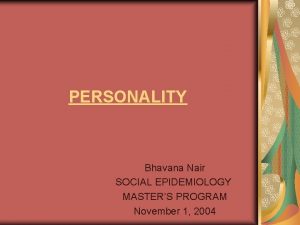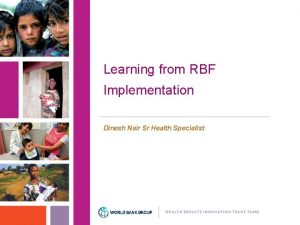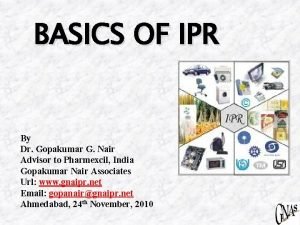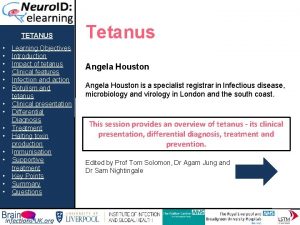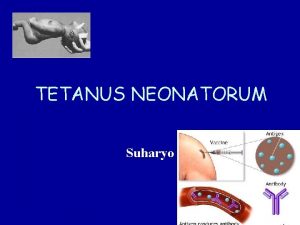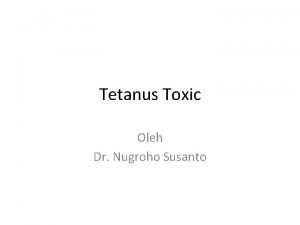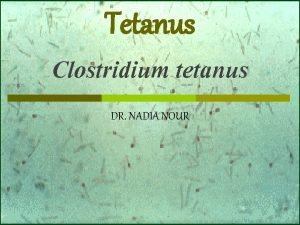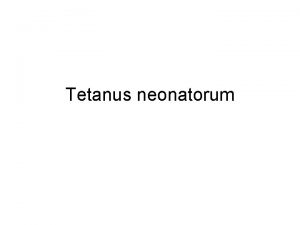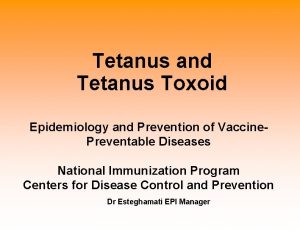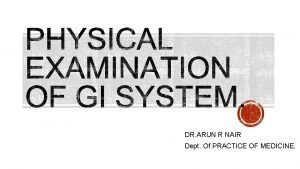TETANUS DR Arun R Nair SKHMC Definition Tetanus
















- Slides: 16

TETANUS DR. Arun R Nair SKHMC

Definition Tetanus is a neurologic syndrome characterized by generalized rigidity and convulsive spasm of skeletal muscles caused by a neurotoxin elaborated at the site of injury by Clostridium tetani. The Pathogen C. tetani is an anaerobic, gram-positive, slender, motile bacillus. When it sporulates, the terminal spore gives the organism a characteristic “drumstick” or “tennis racket” shape. The vegetative form produces tetanospasmin (a neurotoxin).

EPIDEMIOLOGY v C. tetani can be found in 2 to 23% of soil samples, with the highest yield in manure-treated soil. v The organism can also be found in stool from a variety of domestic and farm animals and poultry. v Most common in warm climates and in highly cultivated rural areas. v The greatest problem occurs in resource-limited countries because of high numbers of unimmunized mothers and unhygienic practices.

PATHOBIOLOGY § Tetanospasmin, also known as tetanus neurotoxin or Te. NT. 2. 5 ng/kg is a lethal human dose. § Clinical tetanus usually results from entry of the organism into a wound and low oxygen conditions that allow spore germination and survival of the vegetative organism to produce toxin. § Entry is usually through a traumatic or surgical wound, drug injection site, burn, skin ulcer, or infected umbilical cord. § Tetanospasmin acts on both the α and δ motor systems at synapses, resulting in disinhibition. § Tetanospasmin binds the peripheral nerve terminals and is then carried intra-axonally within membrane-bound vesicles to spinal neurons at a transport rate of approximately 75 to 250 mm/day.

§ The light chain passes to the presynaptic terminals, where it blocks the release of neurotransmitters in inhibitory afferent motor neurons. § Loss of the inhibitory influence results in sustained muscle contraction. § Binding of the toxin is irreversible, so recovery requires the generation of new axon terminals. § It also produces neuromuscular blockade and skeletal muscle spasm and acts on the sympathetic nervous system. § The end result is marked flexor muscle spasm and autonomic dysfunction.

CLINICAL MANIFESTATIONS ü The usual incubation period is 3 to 21 days (mean, 8 days), depending largely on the distance between the site of injury and the central nervous system. ü A short incubation period is associated with more severe symptoms. ü Forms of tetanus include generalized, local, cephalic, and neonatal. Generalized tetanus is characterized by a persistent tonic spasm with brief exacerbations. ü The neck and jaw are almost always involved. ü Trismus (lockjaw) is the initial complaint in 75% of cases, so the patient is often initially seen by a dentist or oral surgeon.

ü Other early features include irritability, restlessness, diaphoresis, and dysphagia with hydrophobia and drooling. ü Persistent spasm of the back musculature may cause opisthotonos. These early manifestations reflect involvement of the paraspinous muscles. ü With progression, all muscles contract, with stronger muscles overtaking weaker muscles. ü Noise or tactile stimuli may precipitate spasms and generalized convulsions. ü Involvement of the autonomic nervous system may result in severe arrhythmias, blood pressure oscillation, profound diaphoresis, hyperthermia, rhabdomyolysis, laryngeal spasm, and urinary retention.

ü In most cases, the patient remains lucid and afebrile. ü The condition may continue for 3 to 4 weeks, despite antitoxin therapy, because of the time required for intra-axonal toxin transport. ü Complications include fractures from sustained contractions, pulmonary emboli, bacterial infections, and dehydration. ü Death results from aspiration, hypoxia, respiratory failure, cardiac arrest or exhaustion. ü Mild cases with rigidity usually recover. ü Poor prognostic indicators include short incubation period, short onset time and extremes of age. .

v Localized tetanus is a milder form of the disease. Pain and stiffness are confined to the site of the wound, with increased tone in the surrounding muscles. Recovery usually occurs. v Cephalic tetanus is uncommon but invariably fatal. It usually occurs when the portal of entry of C. tetani is the middle ear. Cranial nerve abnormalities, particularly of the seventh nerve, are usual. Generalized tetanus may or may not develop. v Neonatal tetanus is usually due to infection of the umbilical stump. Failure to thrive, poor sucking, grimacing and irritability are followed by the rapid development of intenserigidity and spasms. Mortality approaches 100%.

Diagnosis Few diseases resemble tetanus in its fully developed form and the diagnosis is therefore usually clinical. Rarely, C. tetani is isolated from wounds. The differential diagnosis depends on the dominant clinical features and includes dystonic reactions as a result of neuroleptic toxicity, seizure disorders, hypocalcemic or alkalotic tetany, alcohol withdrawal, and strychnine poisoning.

Clostridial Myonecrosis (Gas Gangrene) Definition Clostridial myonecrosis, or gas gangrene, can be caused by several Clostridium species, most commonly C. perfringens after trauma or tissue injury. Epidemiology Gas gangrene has historically been a complication of battlefield injuries and of trauma in noncombat settings. Traumatic injuries, vehicular accidents, crush injuries, industrial accidents, gunshot wounds, and burns. Postoperative complications -the appendix, biliary tract, or intestine.

Pathobiology Clostridia are widely distributed in nature and can be cultured from nearly all soil samples, from environmental sites in the hospital, and from the human intestine. A critical factor is a physiologic state of the wound with conditions that support germination and toxin production by toxigenic clostridia. Particularly critical are a low oxidation-reduction potential, hypoxia, appropriate substrates, and calcium ions. C. perfringens elaborates at least 12 recognized toxins, most importantly α-toxin and θ-toxin of C. perfringens type A. α-toxin, a phospholipase C, and θ-toxin or perfringolysin O, a cholesteroldependent cytolysin, in the extensive cell death and disruption of microvascular perfusion that are characteristic of clostridial myonecrosis.

Clinical manifestations v Initial symptoms of traumatic myonecrosis usually occur 1 to 4 days after the precipitating event, although the range is 8 hours to 3 weeks. v The initial symptom is pain that is often sudden and severe at the site. v The involved skin has intense edema and is initially pale before progressing to a bronze or magenta color, followed by the formation of bullae. v The bullae contain fluid that may be clear or hemorrhagic. v The discharge has an odor that is described as “foul-sweet. ”

v About 15% of patients have bacteremia that is usually complicated v by rapid hemolysis with a dramatic drop in the hematocrit, which maybeven decrease to 0%. v Common complications include jaundice, hypotension, hepatic failure, and renal failure. v The renal failure is often due to hemoglobulinuria and myoglobulinuria, but it may also be due to acute tubular necrosis from hypotension. v Despite the severity of the illness, the patient’s mental status is usually remarkably good until very late in the disease.

Uterine gas gangrene, which was once common after septic abortions, is now rare but may complicate normal delivery, amniocentesis, caesarean section, or abortion. The onset is usually sudden, with fever, tachycardia, hypotension, renal failure, and jaundice. Radiography may show gas in the uterine wall. The urine is often “port wine” in color as a result of hemoglobulinuria, and there is often jaundice because of massive intravascular hemolysis.

DIAGNOSIS The diagnosis of gas gangrene is usually based on a constellation of characteristic clinical features, including myonecrosis, shock, and renal failure. The patient typically complains of severe pain. Early recognition is important because early institution of treatment may strongly influence the prognosis. The diagnosis is established by examination of skin and muscle, which shows putrid discharge, characteristic bullae, and crepitations. Gram stain demonstrates abundant gram-positive bacilli and no inflammatory cells. Histopathologic examination of the lesion shows myonecrosis without polymorphonuclear leukocytes, Gas is present in the tissue and may be detected by physical examination, radiography, or other imaging methods.

